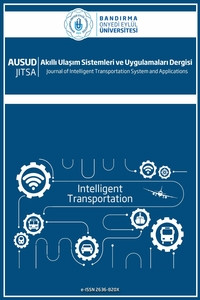Öz
Çatışma kazaları deniz kazalarının önemli bir yüzdesini oluşturmakta olup, uluslararası ve ulusal kurallar dahilinde birçok önlem alınmasına rağmen halen yaşanmaya devam etmektedir. Çatışma kazaları sonrası gemilerin kusur dağılımının belirlenmesi aşaması mahkemeler tarafından görevlendirilen bilirkişilerce yürütülmektedir. Bu süreç çatışmayı önleme kurallarının uygulanmasındaki ihlallerin tespit edilerek yüzdesel kusur oranının belirlenmesi şeklinde gerçekleştirilmektedir. Oldukça karmaşık ve çok fazla değerlendirme kriterinin aynı anda göz önünde bulundurulması gereken bu geleneksel yöntem ile problemin karmaşıklığından dolayı objektif karar vermek oldukça zor olabilmektedir. Bu çalışmada bilirkişilere bu noktada karar desteği sağlayabilmek amacıyla çok kriterli karar verme yöntemleri kullanılarak model algoritması oluşturulmuştur. Çatışma kazası analizinde çatışma için uygulamada olan kural kriterlerinin ağırlıklandırılması AHP yöntemi ile yapılandırılmış, aynı kriterler üzerinden gemilerin kusurlarının tespiti için TOPSIS yöntemi kullanılmıştır. Bilirkişilerin çok kriterli karar verme yöntemini kullanacağı excel tabanlı arayüz oluşturulmuş ve emsal karar verilen mahkeme kararları üzerinden model uygulaması yapılmıştır. Bu uygulamalar sonucunda emsal karar verilen mahkeme kararları ile model çıktıları benzer sonuç vermiştir.
Anahtar Kelimeler
Kaynakça
- Amiri, M. P. (2010). Project selection for oil-fields development by using the AHP and fuzzy TOPSIS methods. Expert Systems with Applications, 37(9), 6218-6224.
- Bambulyak, A., & Ehlers, S. (2020). Oil spill damage: a collision scenario and financial liability estimations for the Northern Sea Route area. Ship technology research, 67(3), 148-164.
- Butowski, L. (2018). An integrated AHP and PROMETHEE approach to the evaluation of the attractiveness of European maritime areas for sailing tourism. Moravian Geographical Reports, 26(2), 135-148.
- Cahill, R. A. (1983). Collisions and their causes: Fairplay Publications.
- Celik, M., Deha Er, I., & Ozok, A. F. (2009). Application of fuzzy extended AHP methodology on shipping registry selection: The case of Turkish maritime industry. Expert Systems with Applications, 36(1), 190-198. doi:https://doi.org/10.1016/j.eswa.2007.09.004
- Dağdeviren, M., Yavuz, S., & Kılınç, N. (2009). Weapon selection using the AHP and TOPSIS methods under fuzzy environment. Expert Systems with Applications, 36(4), 8143-8151.
- EMSA. (2021). An overview of marine casualties and incidents 2021. Retrieved from https://www.emsa.europa.eu
- Gao, Q., Peng, S., Lu, X., & Yin, Y. (2022). Evaluation of the economic vitality of the nine cities and prefectures in Guizhou Province based on the entropy weight-TOPSIS method. Paper presented at the 2022 IEEE 6th Information Technology and Mechatronics Engineering Conference (ITOEC).
- Hald, H. J. (2007). Apportionment of Collision Liability: A Survey of Nordic Maritime Collision Case Law. (Doctoral dissertation)
- Ho, W. (2008). Integrated analytic hierarchy process and its applications–A literature review. European Journal of operational research, 186(1), 211-228.
- Hwang, C.-L., & Yoon, K. (1981). Methods for multiple attribute decision making Multiple attribute decision making (pp. 58-191): Springer.
- Iqbal, M., Ma, J., Ahmad, N., Ullah, Z., & Ahmed, R. I. (2021). Uptake and adoption of sustainable energy technologies: Prioritizing strategies to overcome barriers in the construction industry by using an integrated AHP‐TOPSIS approach. Advanced Sustainable Systems, 5(7), 2100026.
- Kara, E. G. E. (2022). Determination of maritime safety performance of flag states based on the Port State Control inspections using TOPSIS. Marine Policy, 143, 105156.
- Kaya, A. Y., Asyali, E., & Ozdagoglu, A. (2018). Career decision making in the maritime industry: research of merchant marine officers using Fuzzy AHP and Fuzzy TOPSIS methods. Zeszyty Naukowe Akademii Morskiej w Szczecinie.
- Khambhati, R., Patel, H., & Kumar, S. (2021). A performance evaluation and comparison model for urban public healthcare service Quality (Urbpubhcservqual) By fuzzy TOPSIS Method. Journal of Nonprofit & Public Sector Marketing, 1-20.
- Nazim, M., Mohammad, C. W., & Sadiq, M. (2022). A comparison between fuzzy AHP and fuzzy TOPSIS methods to software requirements selection. Alexandria Engineering Journal, 61(12), 10851-10870.
- Ömürbek, N., Makas, Y., & Ömürbek, V. (2015). AHP ve TOPSIS yöntemleri ile kurumsal proje yönetim yazilimi seçimi. Süleyman Demirel Üniversitesi Sosyal Bilimler Enstitüsü Dergisi(21), 59-83.
- Pereira, V., & Bamel, U. (2022). Charting the managerial and theoretical evolutionary path of AHP using thematic and systematic review: a decadal (2012–2021) study. Annals of Operations Research, 1-17.
- Qi, J. (2022). Ship collision in Chinese Maritime Law: Legislation and Judicial Practice. Journal of Navigation and Port Research, 46(2), 99-109.
- Qveim-Leikanger, S. (2018). From Manual to Autonomous: One-Hundred Years of Maritime Ship-to-Ship Collision Liability. On the Material Rules and Evaluation of Fault in Collisions between Vessels: Scandinavian Maritime Collision Liability from 1918 to 2018. (Doctoral dissertation)
- Roszkowska, E. (2011). Multi-criteria decision making models by applying the TOPSIS method to crisp and interval data. Multiple Criteria Decision Making/University of Economics in Katowice, 6(1), 200-230.
- Saaty, T. L. (1980). The Analytic Hierarchy Process Mcgraw Hill, New York. Agricultural Economics Review, 70.
- Saaty, T. L. (1986). Absolute and relative measurement with the AHP. The most livable cities in the United States. Socio-Economic Planning Sciences, 20(6), 327-331.
- Saaty, T. L. (1990). How to make a decision: the analytic hierarchy process. European Journal of operational research, 48(1), 9-26.
- Sahin, B., Senol, Y. E., Bulut, E., & Duru, O. (2015). Optimizing technology selection in maritime logistics. Research in Logistics & Production, 5.
- Senol, Y. E., & Sahin, B. (2016). A novel real-time continuous fuzzy fault tree analysis (RC-FFTA) model for dynamic environment. Ocean Engineering, 127, 70-81.
- Şenol, Y., Gökçek, V., & Seyhan, A. (2017). SWOT-AHP analysis of autonomous shipping. Paper presented at the 4th International Multidisciplinary Congress of Eurasia Proceedings.
- Şenol, Y. E., Şahin, B., & Kum, S. (2013). Marine accident analysis by using pairwise comparison. Journal of ETA Maritime Science, 1(2), 59-64.
- TTK. (2011). Kanun No: 6102. Resmi Gazete(27846).
- Uçdu, G., & Kılıç, A. (2022). Investigation of Turkish Ports Within the Scope of Port Location Selection and Green Port. Deniz Taşımacılığı ve Lojistiği Dergisi, 3(1), 35-49.
Ayrıntılar
| Birincil Dil | Türkçe |
|---|---|
| Konular | Mühendislik |
| Bölüm | Makaleler |
| Yazarlar | |
| Yayımlanma Tarihi | 29 Ekim 2022 |
| Gönderilme Tarihi | 12 Temmuz 2022 |
| Kabul Tarihi | 27 Temmuz 2022 |
| Yayımlandığı Sayı | Yıl 2022 Cilt: 5 Sayı: 2 |


